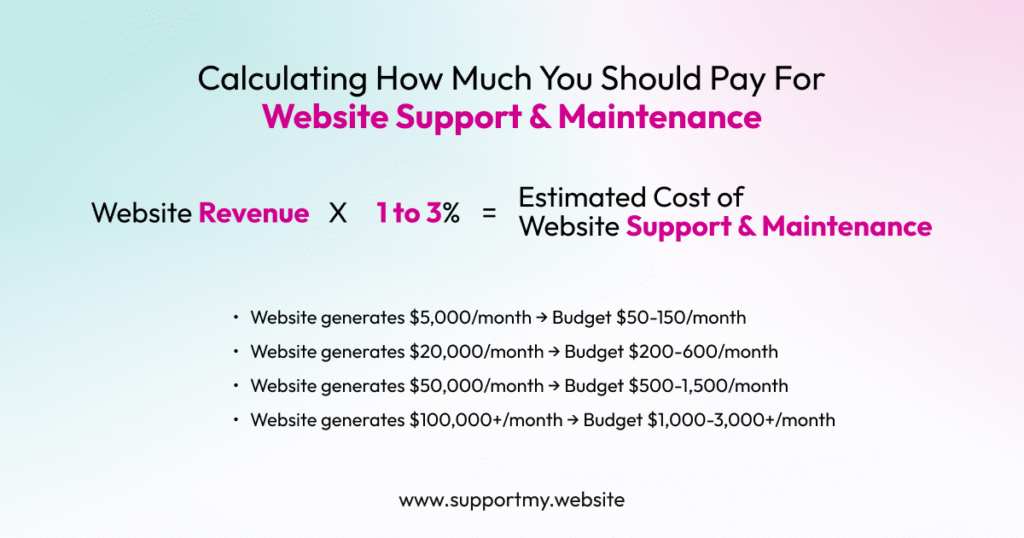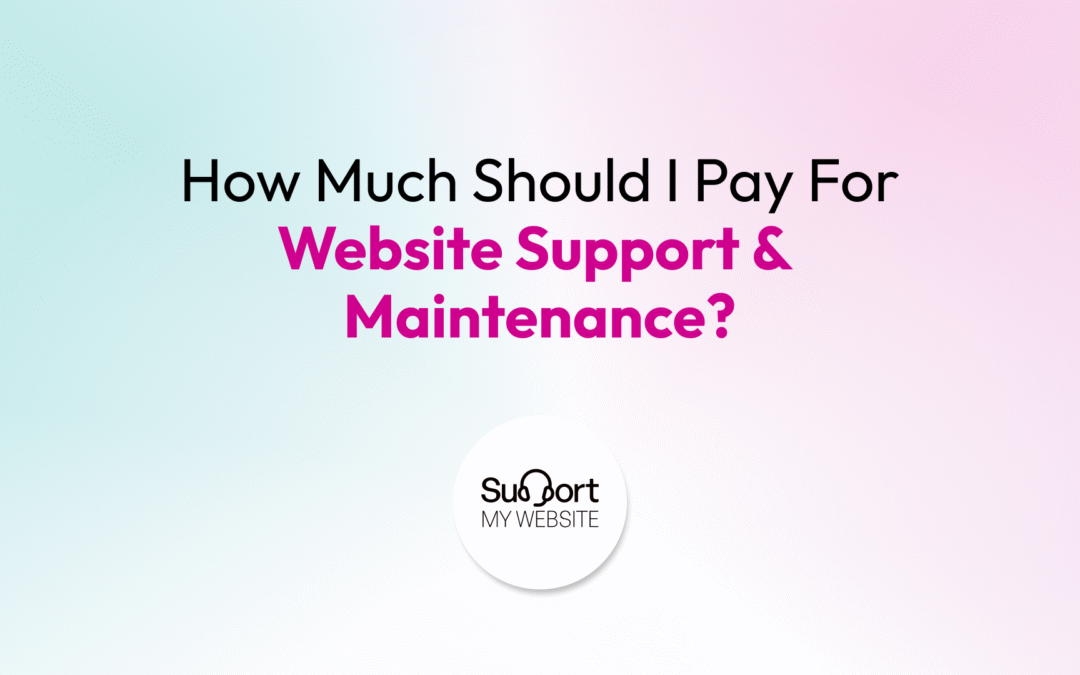This guide covers how much you should pay & what you should expect for website support & maintenance.
Website management pricing can be confusing. It’s like looking at sets of life insurance plans side by side and can make you go cross-eyed. You’ll see services ranging from $25 to $2,000+ per month, and it’s rarely clear what you’re actually getting. Some providers seem expensive while others look suspiciously cheap. So what’s the right number, who should you go with, what are you getting, and most importantly what should you be getting when you pay for website support and maintenance?
The answer depends on your business needs as well as understanding what you’re buying. I’m going to walk you through the different options and top companies (as of November 2025), what the different pricing levels deliver, help you understand what’s being offered and what you should be looking for.
Consider reading what you’re getting at each price level, but if you want to just jump to the list of companies doing website support and maintenance, click here.
An Easy Calculation For Website Support & Maintenance
Website management is a bit of a commodity, but there are big differences when it comes to service, competency of the team, and the ability to do more than just robot-level work. It’s like buying a car. They all look about the same on the outside, but one is going to break down 10 times between 100k and 200k miles and the other one is never going to have a problem.
So, how much should you pay for website support and maintenance? Here’s how we often explain it to clients: Website management should cost 1-3% of your monthly website-generated revenue. This is roughly one third the cost of going down for one day. It is also a ton of savings on your time as well as peace of mind knowing everything is taken care of by a solid company.
Here’s what it looks like in realistic numbers:

Here’s a simple rule of thumb: Website management should cost 1-3% of your monthly website-generated revenue.
Examples:
- Website generates $5,000/month → Budget $50-150/month
- Website generates $20,000/month → Budget $200-600/month
- Website generates $50,000/month → Budget $500-1,500/month
- Website generates $100,000+/month → Budget $1,000-3,000+/month
Admittedly, it starts to break down around the 20k per month range because this doesn’t take into account reputational damage and that peace of mind knowing things are taking care of is more valuable at higher revenue levels.
Pricing Tiers
It’s almost surprising that there aren’t that many support companies out there. For most of them, it’s these tiers apply.
Basic Website Maintenance ($50-150/month)
At this level, you’re getting essential upkeep with minimal human intervention.
Here’s what’s really happening:
- Labor Hours: 2-3 hours per month of actual work
- Service Delivery: Mostly automated monitoring with basic manual checks
- Response Expectations: 24-48 hours for non-critical issues
- Team Involvement: Junior technician handling multiple clients
What you get:
- Plugin and theme updates (tested for basic compatibility)
- Automated backup monitoring
- Basic security scanning
- Uptime monitoring with email alerts
- Monthly summary report
What you don’t get:
- Content updates
- Performance optimization
- Analytics
- Strategic recommendations
- Priority support
- Emergency response
If you’re running a small brochure site, personal blog, low-traffic informational site where brief downtime isn’t really a problem, this is probably fine, and well worth the money.
Red flag: Anything under $50/month at this level means you’re almost certainly getting automated-only service with no human oversight, or very, very little. More than likely, no one is really looking unless they get a notification on their dashboard that something is wrong. There is little to no thinking involved. But, that may be just fine for what you’re looking for. Also, if you’re paying $25/mo there’s a problem because those companies almost certainly can’t afford good monitoring tools for that kind of money.
Standard Website Support & Management ($100-600/month)
This is where actual proactive management begins. At this amount, there is a real person doing real support and maintenance work on a regular basis on your website.
Here’s what’s really happening:
- Labor Hours: 6-8 hours per month dedicated to your site
- Service Delivery: Combination of automation and regular human attention
- Response Expectations: 12-24 hours for standard issues, 2-4 hours for urgent
- Team Involvement: Experienced technician with access to senior support
What you get:
- Everything in Basic, plus:
- Limited content updates (usually 1-2 hours monthly)
- Performance optimization and monitoring
- SEO technical maintenance
- Detailed monthly reporting with insights
- Bug fixes and troubleshooting
- Plugin compatibility testing in staging environment
What you don’t get:
- 24/7 emergency support
- Major development work
- Extensive content creation
- Strategic consulting
If you’re running a small business website, blog with moderate traffic, lead generation site, professional service firm website, and aren’t investing much or anything into lead generation such as ads or SEO, this works great and is well worth the money.
Good for most small to mid-sized businesses: For most small to medium businesses, this tier provides the best value. You get real attention without paying for enterprise-level features you don’t need.
Premium Website Support, Maintenance, & Management ($500-2,000/month)
There is a real person who knows what they are doing looking at your site on a regular basis.
Here’s what’s really happening:
- Labor Hours: 15-20 hours per month focused on your site
- Service Delivery: Proactive monitoring, optimization, and strategic improvements
- Response Expectations: 1-4 hours for urgent issues, often 24/7 availability
- Team Involvement: Dedicated account manager, senior developers available
What you get:
- Everything in Standard, plus:
- Enough content updates and edits to cover your needs
- Advanced performance optimization
- Conversion rate optimization recommendations
- Analytics review and strategic insights
- Priority support with fast response SLA
- Regular strategy calls
- Staging environment for all changes
- Advanced security measures
What you don’t get:
- Major redesigns
- Custom feature development (usually available hourly)
- Marketing strategy beyond technical SEO. Things this doesn’t include are usually things like paid ads management, social media management, conversion rate optimization, and ongoing SEO.
This is great for e-commerce sites, membership platforms, SaaS companies, high-traffic blogs, sites where downtime costs real money and where you are investing in the site and need to know what’s happening and make sure your money isn’t being wasted.
This costs more because you’re paying for expertise, availability, and peace of mind. When your site generates $50,000+ monthly, spending $1,000 for professional management is a 2% insurance policy and you often get a lot more than just insurance out of it. One good recommendation or one big bug found can be the difference of thousands or tens of thousands of dollars.
Enterprise Management ($2,000+/month)
This is for the higher end, mission-critical web properties.Companies that pay us more than $2k per month are banks and credit unions, hospitals, and large financial services businesses to name a few categories. In all these cases, if that website goes down, there is are serious issues and customers/patients are going to be impacted and that will have severe consequences.
Here’s what’s really happening:
- Labor Hours: 30+ hours per month minimum
- Service Delivery: Fully proactive with dedicated team members
- Response Expectations: Immediate for critical issues, often 24/7/365 coverage
- Team Involvement: Dedicated account manager, senior developers, senior designers, strategic consultant
What you get:
- Custom SLA agreements
- Often 24/7 phone support with guaranteed response times
- Compliance management (HIPAA, PCI, GDPR, SOC2, etc.)
- Disaster recovery planning and testing
- Custom development hours included
- Monthly strategy sessions
- Advanced analytics and reporting
- Multiple environment management
- Load testing and optimization
If you are a large e-commerce operation, enterprise SaaS platform, high-traffic publisher, financial service business, healthcare organization, or any business where website downtime means significant revenue loss and many teams affected, this is what you want.
Already paying someone? Here’s how to know if you’re getting ripped off.
We’ve had a lot of people come to us from other vendors over the years and it’s almost always the same set of problems we see at those vendors.
Probably a bad idea if…
- “Unlimited Everything” – Nobody, I mean NO ONE can offer quality unlimited support profitably. It’s just not a thing. If someone tells you otherwise, they are lying to you.
- Hidden Fees – You shouldn’t have hidden fees. This stuff isn’t rocket science and everything should be clearly laid out in the contract.
- Forcing You To Buy Hosting – Some companies make you buy their hosting as well. It’s not a bad idea a lot of the time, but you shouldn’t HAVE to buy it as well, especially if you’ve already paid for it elsewhere.
- No Clear SLA – If they can’t define response times or they don’t have uptime guarantees or at least something close to one, watch out.
- Required Extended Contracts – Twelve-month contracts with no monthly option is normal at the enterprise level, but not for small businesses. If they don’t have the option for you to do a few months to test them out, may be a good idea to look somewhere else.
Warning Signs
- It’s Too Cheap ($25/month or less) – The economics just don’t work. Even 30 minutes of human attention per month costs more than this.
- No Emergency Protocols – If they can’t explain what happens if your site goes down at 2am, that’s a problem
- No Proactive Monitoring – If they don’t monitor your site with a software solution and you have to tell them when something’s wrong, they are doing it wrong.
- One-Size-Fits-All – If they can’t customize their services that’s a red flag.
- Poor Communication – Takes days to respond to an inquiry is a red flag for any company, but especially one where you need them to be on top of this kind of thing.
Questions about website support and maintenance companies
Q: Can’t my hosting company just handle this?
No. Hosting companies manage servers, not websites. They’ll tell you “the server is fine” while your website is down, and they are probably right. You need website-specific expertise.
Q: Should I bundle hosting and maintenance?
Pros: Single point of contact, often better integration, sometimes cost savings Cons: Less flexibility, all eggs in one basket
For simple sites, bundling makes sense. For complex sites, best-in-class hosting + best-in-class maintenance might be better.
Q: What if I need more than what’s in my plan?
Reputable providers offer hourly rates for additional work, typically $100-200/hour. Get this rate in writing before signing up.
Q: Can I change plans later?
Most providers allow upgrades anytime. Downgrades are typically allowed at renewal. Read the contract carefully before signing.
Q: How long are the contracts?
Most offer month-to-month after an initial 3-6 month commitment. Some discount annual prepayment. Avoid providers requiring longer commitments without flexibility.
Q: What if they damage my site?
Reputable providers carry insurance, test in staging first, maintain backups, and will restore at no charge if they cause issues. This is why you avoid suspiciously cheap providers.
Making Your Decision
Website management isn’t an expense—it’s insurance against downtime, security breaches, and lost revenue. The question isn’t whether you can afford it, but whether you can afford to go without it.
Here’s the reality:
- DIY costs $1,000-2,000/month in your time
- Cheap services (<$50/month) provide automated solutions, but often aren’t large enough organizations to have senior people on staff to solve complex problems
- Professional services ($100-2,000/month) deliver measurable ROI
How to figure out how much to pay for website support and maintenance:
- Calculate your website’s monthly revenue
- Budget 1-3% of that for management
- Choose a provider in that range with features you need
- Don’t sign an annual contract
- Test for 90 days
- Switch if it’s not working
At the end of the day, one prevented security breach, one major performance improvement, or one avoided day of downtime pays for the cost of website management. Your website is a major business asset that you probably paid a lot of money for. Protect it accordingly.
Author:
Jason Long, CEO

Jason Long is the founder and CEO of JHMG and SupportMy.Website. He is a serial problem solver and entrepreneur with 25 years of experience in business building. Jason’s ventures range from agriculture to healthcare with a focus on web-based technology. He has extensive experience in software development and have operated as a developer, UX designer, graphic designer, project manager, director, executive coach, and CEO. At JHMG, he operates not only as the leader of the organization, but also as a SaaS Consultant helping businesses start, build, grow, scale, and exit their SaaS businesses.
Jason is also an experienced world traveler who regularly visits destinations worldwide, and is passionate about community growth, social issues, fitness, and family.
Jason Long’s Linkedin
Website: JasonMLong.me
X: @jasonmlong
